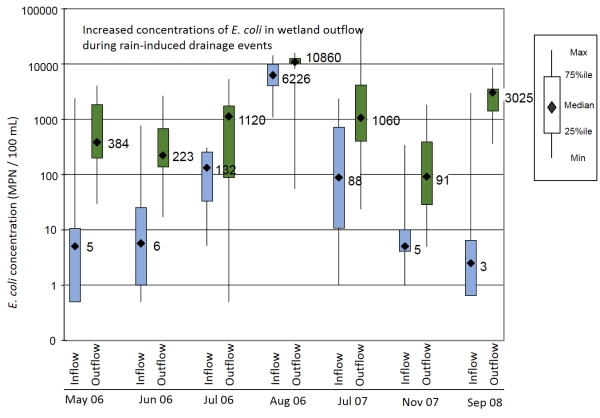Constructed wetlands treating agricultural drainage waters are expected to show some removal of the faecal indicator bacterium, Escherichia coli (E. coli). However, recent research by NIWA has found that a wetland treating episodic (rain event driven) subsurface drainage from grazed dairy pasture appeared to be a net exporter of E. coli.
Monthly monitoring of farm drainage to the wetland during the wetter months of the year found higher concentrations of E. coli in the outflow than in the inflow. This is a surprising finding given that constructed wetlands treating domestic sewage usually achieved net removal of E. coli.
We investigated this unexpected finding by seeing whether the increase in E. coli might be an artefact of a sampling regime which was biased towards flow recession after rain events. Testing this hypothesis entailed chasing rain-induced drainage events using time-based and flow-proportional sampling with calculation of inflow and outflow fluxes (cfu/s) and loads (cfu/event and cfu/yr) – culminating in the eventual conclusion that the wetland was indeed a net exporter of E. coli with increases in E. coli export ranging from 2 to 34 fold over seven events.
The increase in E. coli is probably due partly to wildlife deposition, but genetic and other evidence suggests that the main source is growth of this bacterium as environmental ‘naturalised’ populations within the wetland. This raises interesting questions regarding the microbial ecology of E. coli, its use as a faecal indicator and interpretation of E. coli-based water quality in relation to waterborne disease and the human health risk downstream from wetlands and potentially other nutrient and/or organic-rich vegetative environments.
Monitoring data illustrating net export of E. coli from the wetland.



